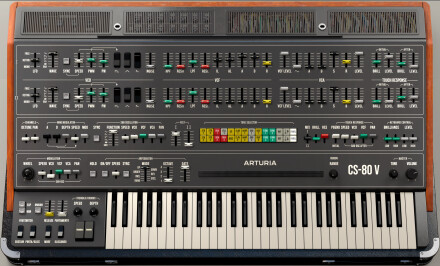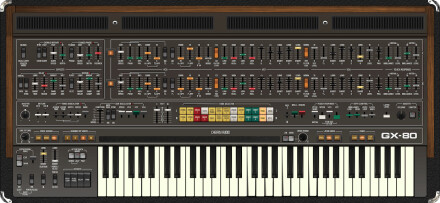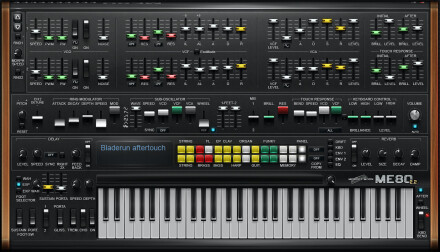When one of the world's most renowned software emulators of legendary synthesizers decides to offer its own interpretation of the Yamaha CS80, curiosity is bound to be piqued. Let's find out what sets XILS-lab's version apart from the competition.

If someone says “French company based in Grenoble, known for its high-flying models of legendary synthesizers”, you think of… XILS-lab. No?
Relatively discreet, but renowned for the excellence of its modeling, Xavier Oudin’s company has released a fine collection of synthesizers, vocoders and effects since 2009. These include the fantastic software interpretation of the PolyKobol II, the PolyKB III, and the reproduction of the Roland RS-505, the XILS 505. Another synthesizer worth mentioning is the Oxium. This one features a proprietary architecture designed to unify analog and modern sounds.
What’s more, like with the Minimoog and Prophet-5, software emulations of the CS80 are now numerous. We’ll come back to the various competitors later.
The Yamaha CS-80: history and characteristics of a mythical synth
Before we dive into The Eighty, let’s take a look at its illustrious inspiration, the Yamaha CS80, which is often considered the pinnacle of vintage analog synthesizers.
The story of the CS80 begins with the Yamaha GX-1. Released in 1975, this colossal instrument belongs to an era when the first polyphonic synthesizers were making their appearance. A veritable monster weighing almost 400 kg (!), the GX-1 offered 18-voice polyphony divided between three keyboards and a pedalboard. Designed at great expense (we’re talking over $23 million in development), it was primarily intended to demonstrate Yamaha’s know-how, and sold for $60,000 at the time (editor’s note, I’ll let you do the conversion).
On this technological foundation, Yamaha quickly developed a range of more accessible instruments, at least in size and price (it’s all relative!). The CS50, CS60 and CS80, the latter being the flagship model of the series.
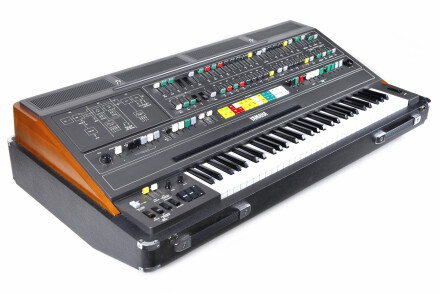
One of the revolutionary aspects of the CS80 lies in its fully integrated approach to polyphony. Unlike earlier polyphonic models, which were often built around a modular structure such as Oberheims with SEM modules, the CS series provides global timbre control, avoiding the need to adjust each voice separately. Another major innovation is that the CS80 is one of the first synthesizers to feature memories. On the one hand, a series of colored buttons provides access to pre-programmed sounds (Strings, Brass, E Piano…), and on the other, four user memories allow you to save your own settings. These memories are programmed via small sliders concealed beneath a hatch, faithfully reproducing the parameters of the main panel. They can be quickly recalled via buttons appearing next to the fixed memories.
The CS80 also offers velocity sensitivity and polyphonic aftertouch, which, combined with a ribbon controller, give it outstanding expressiveness. Even today, it remains one of the most expressive synthesizers ever marketed. Added to this is a bewitching richness of timbre. Just listen to Vangelis’ Chariots of Fire and Blade Runner soundtracks.
Unfortunately, the CS80 was released in the same year as the Sequential Circuits Prophet-5. The latter relies on a microprocessor for polyphony and memory management, making it more practical to use. This advantage, coupled with a more compact size and a much lower price, worked in its favor.
Graphic interface of The Eighty: ergonomics, presets and first steps
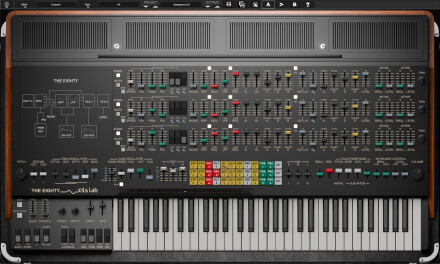
The elegant graphical interface broadly mirrors the look and layout of the CS80 controls. In the context of vintage synthesizer modeling, this approach makes sense, as the user is often looking for sonic fidelity as much as a specific workflow. Several display sizes are available, but changing them requires restarting the plug-in. While the whole thing is pleasant to use, the interface remains rather cumbersome. It would have been a good idea to include an option to hide certain sections to optimize screen space.
At the very top of the interface, a toolbar gives access to various general settings and presets, organized using three drop-down menus. The latter allow you to filter sounds according to criteria such as bank, sound type or preset author. The preset browser does the job. It features a tag and favorites system, but no search function.
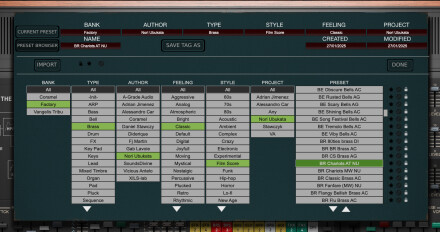
The CS80 is renowned for its expressive, brassy sounds. With The Eighty, these characteristics are easily echoed*. Very much at home with brass and string tones, it also excels in expressive bass and leads, with a distinct identity far removed, for example, from the character of a Moog or Oberheim. Thanks to its particularly comprehensive ring modulator, it also shines in the creation of special effects, bells and various metallic sounds.
Full MIDI control is also offered. Note that the LFO speed parameters, whether tempo-synchronized or in free mode, remain the same. This is a relatively rare feature in plug-ins, yet a very practical one, as it avoids having to assign two controllers to the same parameter. As for the CS80's polyphonic aftertouch, it’s faithfully reproduced, offering a nice progressive response. Unfortunately, no MPE.
No history or undo function either. As this can vary between DAWs, it may be worth checking whether the one used supports plug-in history. Throughout the test, The Eighty proved stable, with average resource consumption for this type of plug-in. On the other hand, opening it takes longer than expected. For the record, a small graphics bug was present in the VST3 version, but was corrected the day after I reported it. XILS-Lab’s responsiveness and efficiency are commendable.
More generally, having scoured various forums and discussions, it’s clear that customer support is much appreciated. What’s more, previously released plug-ins are not sidelined and continue to benefit from regular improvements.
Sound structure of The Eighty: three lines of synthesis for a rich sound

Then there’s a high-pass filter followed by a low-pass, both with a slope of 12 dB/oct. Each has its own resonance, which isn’t so common. Although they don’t self-oscillate, the resonances don’t overwhelm the signal. The color they bring is particularly pleasing, and the combination of the two proves very effective in sculpting the sound.
These filters can be deactivated individually to save CPU. They are controlled by a rather special envelope, comprising an initial level, an attack level, an attack time, a decay and a release. Next comes a VCA, this time with a classic ADSR envelope. These envelopes are very fast. They make such snappy sounds that it’s sometimes necessary to soften the attack.
Each synthesis line offers its own velocity (called Initial here) and polyphonic pressure [after] settings for filters and VCA. In addition, The Eighty also lets you adjust the panning, as well as deactivate or mute the line. The third line is a welcome bonus. Even on classic presets, simply copy one of the two lines to the third, set a different pitch and slightly adjust a few parameters to bring even more body and foundation to a sound.

A general LFO is also present, named “Sub Oscillator.” This could be confusing for those used to subtractive synthesis, but these unusual names are part of the charm of the old Japanese synthesizers, which sought to distinguish themselves from their American competitors (editor’s note: see early Korg). This LFO offers sine, triangle, descending sawtooth, ramp, square and noise waveforms. It can modulate VCO, VCF and VCA and be tempo-synchronized.
It’s also in this section that you set the pitch of each VCO, either according to the CS80's default steps (16', 8', 5⅓ “, 4', 2⅓ ”, 2'), or more finely via a right-click. A general filter control is also available (brightness, resonance).
The Chorus/Vibrato, is of course present, with its speed and depth settings, and seems faithful to the original in offering a lovely, very silky color. The graphic interface takes over from the “ribbon controller”, which here acts as a simple pitch bend.
Very complete, The Eighty’s synthesis is a real little marvel. It allows you to do many things while remaining simple, once you’ve assimilated the instrument’s philosophy.
Features of The Eighty : modulation, arpeggiator and effects
Hidden on the left, beneath the silk-screened synthesis schematic, at the point where, on the CS80, a hatch gives access to the mini-sliders for preset configuration, is a 2D mixer. For mixing three lines, this solution is far more practical than the three remaining sliders in the control section. It can also be animated using two algorithms (Circle and Random), with intensity and speed settings.
The other additions are hidden beneath the ventilation grids at the top of the GUI. First of all, there are the general settings, such as number of voices (up to 16), voice operating mode (circular or reset), mono modes (Low, Last, High), legato and unison of up to six voices.
Then comes a twelve-cord modulation matrix, three of which have a fixed source (mod wheel, aftertouch, velocity), a welcome addition to breathe even more life into a synth that’s got plenty already. There’s no need to list all the sources and destinations, but the possibilities are numerous. For example, effect parameters can be modulated with noise or oscillators. (Big fun and sleepless nights of sound design guaranteed!)

The CS80 is a synth that really comes into its own when effects are added, especially a nice reverb like a Lexicon 224, for example. In fact, some musicians who have played the synth and expected the same fullness as on mixed, effects-laden records have found themselves frustrated. XILS-Lab, like others, understands this and has included a small collection of effects that can be positioned in any desired order: a stereo delay, a phaser, a reverb with three modes (Small, Medium, Large), an equalizer to which the latest version adds the PolyM Resonator (the Polymoog model).
Despite a limited number of parameters, all these effects are of excellent quality and enable you to quickly achieve the sound you’re looking for. They are added to the Chorus/Tremolo already present.
The Eighty face-to-face with other CS-80 emulations
Let’s take a look at The Eighty’s competitors.
First up, the Arturia’s CS-80V. It presents itself, as usual with this brand, under a neat and elegant graphic interface. Preset management is based on the in-house browser, which is both intuitive and efficient, with a well-designed, perfectly usable collection. Emulation is of high quality, but seems to lag behind The Eighty. There’s a nice palette of effects, as well as a few modulation-focused additions.
Softube’s Model 77 features an interface more reminiscent of the CS50 – or even the CS60 – than the CS80. Parameter names have been standardized (LFO replacing sub-oscillator, for example), and the two synthesis lines are separated into two distinct views. While this simplifies the interface, it also makes programming less practical, as the user must constantly navigate between pages. True to its philosophy, Softube has opted for a minimalist approach, avoiding burdening the instrument with additional functionalities. Aware, however, that reverberation is essential for a CS80 to express itself fully, this effect has been integrated, albeit limited to a single intensity slider. On the sound side, while Softube impressed with its Prophet-5 model, the Model 80, the Model 77 leaves a more mixed impression. Rendering seems relatively flattering in the midrange, but outside this zone, the sound lacks fullness, with occasionally aggressive highs.
The Cherry Audio GX-80 presents well with a relatively well-thought-out, if somewhat confusing, interface. The preset browser is efficient and offers a fine collection of sounds. One of the special features is the presence of a model of the GX-1 filter, hence its name. The GX-80 goes even further than The Eighty, offering four lines of synthesis spread over two layers. A few medium-quality effects complete the package. Regarding sound, the GX-80 is a far cry from the CS80. The rendering is mainly centered on the midrange, with a straight, aggressive sound. On the other hand, this predominance of midrange makes it easy to place in a mix.
Finally, let’s mention the Memorymoon ME80, available only on Windows, which couldn’t be tested here. Underneath a somewhat dated graphical interface, its fidelity to the original instrument is often praised by CS80 owners.


